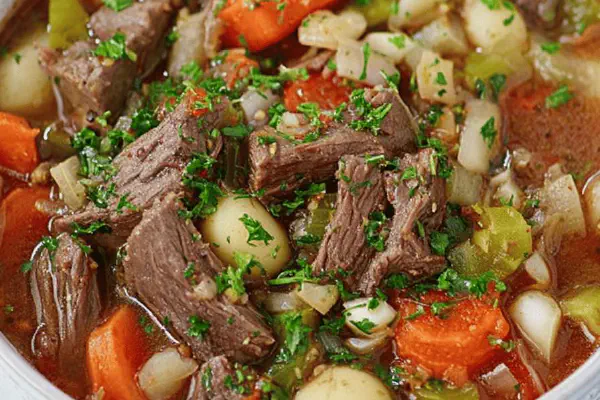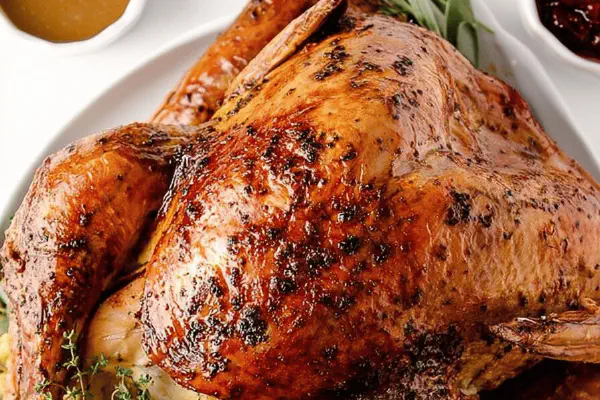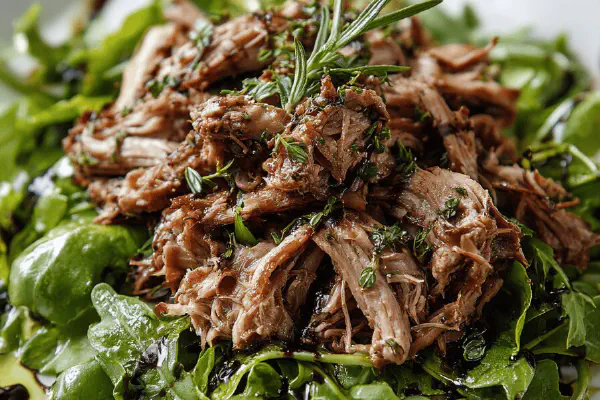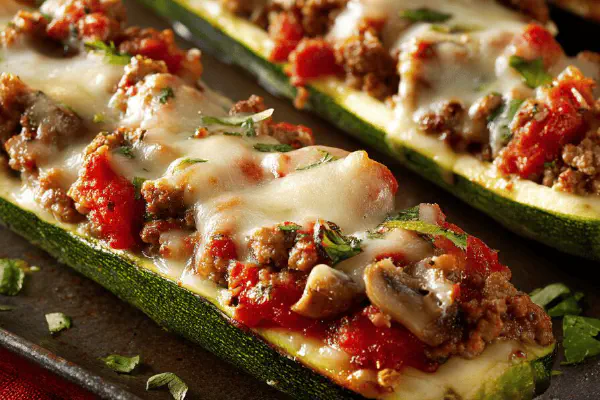Spiced Butter Roast Turkey
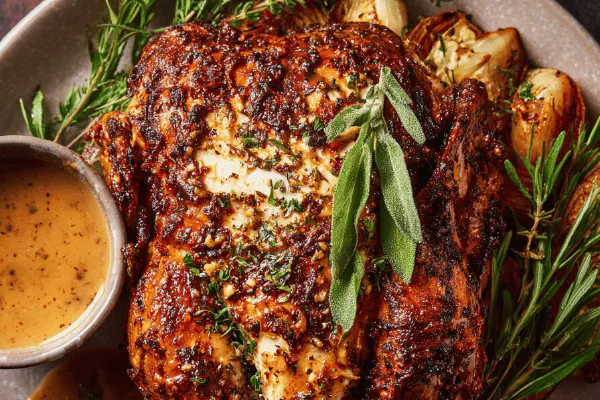
By Emma
Certified Culinary Professional
Ingredients
- 1 fresh or frozen turkey about 7 kg (16 lb)
- 45 ml (3 tbsp) fine table salt
- 125 ml (½ cup) unsalted butter softened
- 10 ml (2 tsp) dry mustard powder
- 2.5 ml (½ tsp) ground cinnamon
- 2.5 ml (½ tsp) ground allspice instead of nutmeg
- 2.5 ml (½ tsp) smoked paprika instead of coriander
- 500 ml (2 cups) reduced-salt chicken stock
- 1 onion diced
- 4 garlic cloves lightly crushed
- 45 ml (3 tbsp) unsalted butter
- 75 ml (1/3 cup) cognac
- 2 liters (8 cups) reduced-salt chicken broth
- 1 tomato diced
- 15 ml (1 tbsp) apple cider vinegar replacing Worcestershire sauce
- 3 bay leaves
- 45 ml (3 tbsp) cornstarch
- 45 ml (3 tbsp) water
- Salt and black pepper freshly ground
About the ingredients
Method
= Turkey =
- Start with a dry turkey, cavity dry - salting inside with 10 ml fine salt. Rub remaining salt on skin, thighs. Cover. Fridge 48 hours. Frozen? The salting thaws it naturally, flavor seeps in. Skin tightens, less water. Keeps bird juicy but skin crisp later. I’ve tried brining, but salt only, yields better roast.
- Position oven rack low, preheat to 230 °C (445 °F). Hot start seals skin fast, renders fat early, sounds start—sizzle, pop.
- Mix softened butter with dry mustard, cinnamon, allspice, smoked paprika. Not nutmeg here; allspice adds deeper warmth, smoked paprika a hint of smoke. Tweak spices if you want heat or earthiness — try chipotle for bold.
- Pat turkey skin dry with paper towel. Carefully loosen skin with fingers from breast and thighs — no tears. Use spoon back for stubborn spots. Spread butter mix evenly beneath skin. This trick renders the skin flavorful, fat bastes meat directly. Saves basting later.
- Place bird breast-side up on rack in roasting pan. Pour stock into pan bottom—it creates moisture barrier preventing drippings from burning. Doesn't drown the skin.
- Slide turkey into hot oven 30 minutes. Crisp skin forms, bubbling fat, rich aroma fills kitchen.
- After 30, reduce heat to 160 °C (325 °F), roast uncovered about 1hr 40 min more, use instant thermometer to check inner thigh 79 °C (175 °F). I prefer slightly less temp inside to avoid dryness but let rest time finish cooking. Skin should crackle when poked but not burn. Juices run clear.
- Remove from oven, tent loosely if cooling aggressively dries skin. Let rest 30 minutes uncovered. Rest is vital to redistribute juices—cutting now steals it all.
= Sauce =
- Sauté diced onion and crushed garlic in butter over medium heat. Softening until golden, aroma ramps up. Avoid browning too dark.
- Flambé with cognac carefully—flames ignite, caramel notes deepen sauce. No cognac? Use dry white wine or apple juice for sweetness.
- Add broth, diced tomato, apple cider vinegar, bay leaves. Vinegar brightens acidity, balances sweetness. Simmer, reduce by half—watch for rich sauce bubbling, thickening, deep color.
- Mix cornstarch with water to slurry, drizzle slowly into sauce whisking constantly to avoid lumps. Simmer 1 min solidifies body. Add salt and pepper to taste.
- Strain if needed or leave chunky for rustic feel. Serve warm alongside turkey slices, pour over or dip.
= Tips & Tricks =
- Butter under skin key: protects breast meat from drying, flavors skin from inside out. Be gentle peeling skin; tears cause butter loss.
- Dry brine two days ahead is gold. Timing is flexible up or down half day but not less than 24 hours; saliva breaks down protein, makes crust crisp. Frozen bird? Salt while thawing, saves time and ensures depth.
- High heat start seals skin fat causally. Finish low and slow cooks evenly. Don’t cover with foil while cooking—traps steam, soggy skin. Rest uncovered.
- Sauce acidity balanced carefully; apple cider vinegar less harsh than Worcestershire, works better if you want tang subtle but real. Tomato adds umami.
- Check doneness by feel. Leg should wiggle slightly, thigh skin tight but pliable, juices clear. Thermometer is backup, not sole judge.
- Avoid overcooking at expense of skin and flavor. Remove bird from heat slightly shy of target, use residual heat to finalize.
- I avoid basting during roast; disturbs heat, dries skin. Rely on butter, pan juices, humidity from broth in roasting pan bottom.
- Substitutions: Use ghee for butter if lactose-sensitive, increase salt a touch as ghee less salty. No cognac — try apple brandy or omit, replace volume with broth.
- If stock too salty, dilute with water, taste frequently. Sauce thickens quickly — remove from heat once thickened to prevent glue.
- Best carving tip: cool 30 min before slicing. Cuts clean, juices won’t spill everywhere. Skin stays crisp.
- By experience, no covering during rest maintains crackle; tight foil creates steam and sogginess.
- Perfect for holiday spreads but adaptable any time — smaller birds cook shorter, apply same techniques.
Cooking tips
Chef's notes
- 💡 Dry brine in fridge 48 hours minimum. Spread fine salt inside cavity and under skin gently. Frozen bird? Salt while thawing—flavor seeps as ice melts. No soaking in water or heavy brine that softens skin. Pat skin dry before butter rub. Moisture kills crispness.
- 💡 Butter mix thick but soft. Dry mustard and cinnamon give warmth. Swap nutmeg for allspice adds deeper notes. Smoked paprika replaces coriander, brings subtle smokiness without overpowering. If heat wanted, chipotle powder optional. Spread under skin evenly—fingers and spoon back useful. No tears or butter leaks.
- 💡 Oven strategy: preheat to 230 °C (445 °F), rack low to avoid burning bottom. Hot blast seals skin, renders fat, makes skin bubble sounding sizzle and pop. After 30 min reduce to 160 °C (325 °F). Roast slow till thermometer hits 79 °C (175 °F) inner thigh. Let residual heat finish cook. Juices run clear, leg wiggles slightly.
- 💡 Sauce builds with sautéed onion and crushed garlic in butter—not browned to dark. Add cognac and ignite carefully, caramelizes notes. Replace cognac with dry wine or apple juice if needed. Vinegar brightens acidity, balances sweetness, no fishiness from Worcestershire here. Reduce broth, tomato chunks add body. Slurry cornstarch slowly whisked till thick but not gluey.
- 💡 Rest uncovered minimum 30 minutes. Tent loose foil if chilling aggressively but best no cover. Skin stays crisp, crackles when poked. Juices redistribute, no pooling when sliced. Avoid basting during roast—dry skin risk. Use pan juices and butter under skin fat bastes meat gently. Carve cold for clean slices and less juice loss.
Common questions
Why dry brine so long?
Salt needs time to penetrate. Two days best for deep flavor. Short brining surfaces salt only. Frozen bird? Do while thawing; salt melts with ice, good absorption. Avoid wet brine—kills skin crispness.
Butter mix spices alternatives?
Allspice replaces nutmeg, less sharp, warmer. Coriander swapped for smoked paprika adds subtle smoke notes. Want heat? Add chipotle. No mustard? Use Dijon powder carefully. Butter softness crucial for spreading under skin, not runny.
Skin soggy after roast?
Common if covered while resting or basting too much. Keep uncovered to dry skin surface. No foil tight around bird. High initial heat seals fat, slow roast keeps meat tender. Avoid steaming in pan too much; use just enough broth to protect drippings, not drown skin.
How to store leftovers?
Cool quickly after carving. Store meat slices and skin separate if possible—skin soggy if mixed with juices. Wrap tight or airtight containers. Consume within 3 days. Sauce thickens in fridge; reheat gently with splash water or broth to loosen. Freeze if long term but lose crispness.
